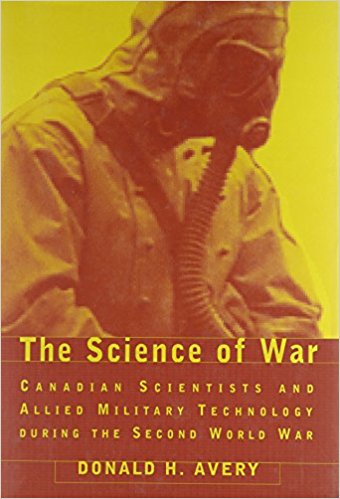The Science of War:
Canadian Scientists and
Allied Military Technology
During the Second World
War
Donald H. Avery
University of Toronto Press Incorporated, 1998
ISBN 0-8020-5996-1
406 Pages
 Those readers who know me from around the Museum may wonder why a
review on a topic like this has taken so long to appear. For those who do
not know me thus, my interest in this subject stems from my own forty-year
involvement in Canadian defence research and development beginning in the
mid-1960s. This book chronicles the origins of the Canadian defence research
organization during the years before, during, and immediately after the Second
World War, and thus serves as prologue for the period during which I served.
Those readers who know me from around the Museum may wonder why a
review on a topic like this has taken so long to appear. For those who do
not know me thus, my interest in this subject stems from my own forty-year
involvement in Canadian defence research and development beginning in the
mid-1960s. This book chronicles the origins of the Canadian defence research
organization during the years before, during, and immediately after the Second
World War, and thus serves as prologue for the period during which I served.
This book makes clear very quickly that the success of Canada's wartime
defence research effort depended very much on four individuals. First,
General Andrew McNaughton, of First World War fame and president of Canada's
National Research Council in the late 1930s, foresaw the vital importance of
science and technology in the upcoming conflict with Nazi Germany, and then
helped orient NRC toward military research. He then, before moving on to his
wartime post in London, England, oversaw the installation of C.J. Mackenzie,
ex Dean of Engineering at the University of Saskatchewan, as his successor,
overseeing Canada's entire defence research effort throughout the war years.
The third individual was Frederick Banting, famous as the discoverer of insulin,
who led work on biological warfare before being killed in an plane crash in
1941; and Otto Maass, a chemist at McGill University, who spearheaded Canadian
research on chemical warfare and explosives production.
These four individuals were, of course, aided and abetted by many other
internationally respected scientists from universities across Canada.
Canada's stature was also enhanced by its ability and willingness to provide
some unique research facilities, notably the Suffield Experimental Station in
southeastern Alberta, the biological warfare research facility on Grosse Isle,
downstream from Quebec City, and the Anglo-Canadian Montreal Laboratory, the
forerunner of the current Chalk River facility and a contributor to the
Manhattan Project to build the atomic bomb.
Because Canada did not have an independent defence research posture during
the Second World War, this book really cannot help but be a digest of "Who did
what to/for who when", because nearly all allied defence research in this
period was a cooperative venture among the United Kingdom, United States and
Canada, with Canada working hard (successfully for the most part) to maintain
a place at the table between the posturing of British scientists and the
immense resources that were mobilized by the United States.
Full disclosure: this book may not be for everyone. It reads like a
doctoral thesis; indeed, some one-third of the volume is footnotes, references,
bibliography and index. But it must also be noted that this book reflects
original research; it is not a digest or commentary on research carried out by
others. It also helps if the reader has some acquaintance with the major
thrusts of allied military R&D during the Second World War, including nuclear
weapons, chemical warfare, biological warfare, radar, the proximity fuse, and
explosives production, particularly of RDX.
Nevertheless, "the past is prologue"; this is where Canada's current defence
research posture came from, and scientific endeavour continues to be vitally
important for the well-being of Canada's military capability. A very
interesting book, even if it does not qualify as a relaxing “good read”.

|

|
Last updated: 23 July 2017
|
 Those readers who know me from around the Museum may wonder why a
review on a topic like this has taken so long to appear. For those who do
not know me thus, my interest in this subject stems from my own forty-year
involvement in Canadian defence research and development beginning in the
mid-1960s. This book chronicles the origins of the Canadian defence research
organization during the years before, during, and immediately after the Second
World War, and thus serves as prologue for the period during which I served.
Those readers who know me from around the Museum may wonder why a
review on a topic like this has taken so long to appear. For those who do
not know me thus, my interest in this subject stems from my own forty-year
involvement in Canadian defence research and development beginning in the
mid-1960s. This book chronicles the origins of the Canadian defence research
organization during the years before, during, and immediately after the Second
World War, and thus serves as prologue for the period during which I served.